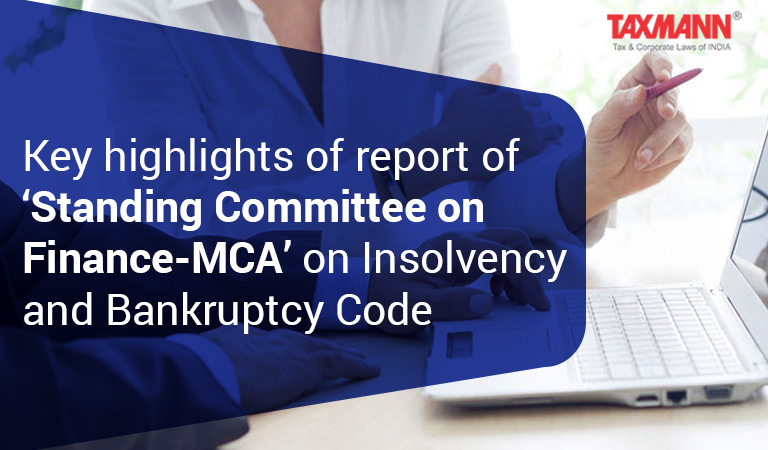Key highlights of report of ‘Standing Committee on Finance-MCA’ on Insolvency and Bankruptcy Code
- Blog|Insolvency and Bankruptcy Code|
- 3 Min Read
- By Taxmann
- |
- Last Updated on 5 August, 2021

The Standing Committee on Finance’- MCA has issued a 32nd report titled ‘Implementation of IBC-pitfalls and solutions’ whereby it has recommended for a benchmark for the quantum of ‘haircut by Financial creditor to be comparable to global standards. The committee proposed the establishment of ‘Institute of Resolution Professionals’ to oversee and regulate the functioning of RPs. It also proposed more transparency in the appointment of RPs by the Committee of Creditors, the inclusion of a more flexible resolution plan, the Adoption of a cross-border insolvency framework, etc. This write-up aims to highlight key recommendations of the committee.
1. Quantum of hair-cut at par with global standards
The Committee found that a low recovery rate with 95% hair cut and delay in the resolution process with more than 71% cases pending for more than 180 days deviates from the objective of the Code. The Committee recommended a benchmark for the quantum of “hair-cut” comparable to global standards.
2. Transparency in the appointment of RPs
The committee noted that during CIRP, the committee of creditors decides whether to continue with IRP as the RP or to replace the IRP with another RP without any guidelines. The committee suggested that IBBI should fame guidelines for the selection of the RPs by the CoC in a more transparent manner.
3. Establishment of ‘Institute of Resolution Professionals’
The Committee recommended putting in place a professional self-regulator like ICAI for RPs. “An Institute of Resolution professionals may be established to oversee and regulate the functioning of Resolution Professionals so that there are appropriate standards and fair self-regulations,” the committee said.
4. Inclusion of flexible resolution plan
The committee highlighted that resolution professional currently doesn’t have flexibility with the IBC to dispose of the corporate defaulter across multiple bidders. The Committee recommended that the IBC be amended to clarify that the resolution plan can be achieved through any of the means prescribed under regulation 37 of the CIRP Regulations.
5. Digitisation of IBC ecosystem
The committee recommended the NCLT and NCLAT should completely digitize their records and operations with provisions for a virtual hearing to get through the backlog and deal with the pending cases swiftly. “All available data should be in a machine-readable format. There should be a broader built-in consultation mechanism and an ecosystem for regular feedback on the performance of NCLT” said the committee.
6. Pre-pack insolvency resolutions
The Committee recommended that the pre-pack framework may be gainfully employed while strictly adhering to the timelines to achieve swift and cost-effective resolutions. The committee recommended that a pre-pack resolution framework for corporates may be rolled out to aid the existing insolvency framework in facilitating quicker and more effective resolutions. Currency MSME are considered operational creditors and come after secured creditors in the ‘waterfall mechanism’.
6. Cross border insolvency
The committee recommends that the adoption of a cross-border Insolvency framework should be expedited as once the recommendations of the ‘cross border insolvency committee’ are adopted, the cross border insolvency framework would go a long way in ensuring coordination and communication between jurisdictions to successfully address the resolution of the cross border insolvency cases.
7. Strengthing home buyers
The Committee recommended that once a single homebuyer decided to initiate insolvency proceedings in NCLT, the real estate owner should be obligated to provide details of other home buyers of the project to the concerned home buyer so that he can mobilise 10% or 100 homebuyers. This move would safeguard the interest of the homebuyer.
Disclaimer: The content/information published on the website is only for general information of the user and shall not be construed as legal advice. While the Taxmann has exercised reasonable efforts to ensure the veracity of information/content published, Taxmann shall be under no liability in any manner whatsoever for incorrect information, if any.

Taxmann Publications has a dedicated in-house Research & Editorial Team. This team consists of a team of Chartered Accountants, Company Secretaries, and Lawyers. This team works under the guidance and supervision of editor-in-chief Mr Rakesh Bhargava.
The Research and Editorial Team is responsible for developing reliable and accurate content for the readers. The team follows the six-sigma approach to achieve the benchmark of zero error in its publications and research platforms. The team ensures that the following publication guidelines are thoroughly followed while developing the content:
- The statutory material is obtained only from the authorized and reliable sources
- All the latest developments in the judicial and legislative fields are covered
- Prepare the analytical write-ups on current, controversial, and important issues to help the readers to understand the concept and its implications
- Every content published by Taxmann is complete, accurate and lucid
- All evidence-based statements are supported with proper reference to Section, Circular No., Notification No. or citations
- The golden rules of grammar, style and consistency are thoroughly followed
- Font and size that’s easy to read and remain consistent across all imprint and digital publications are applied





